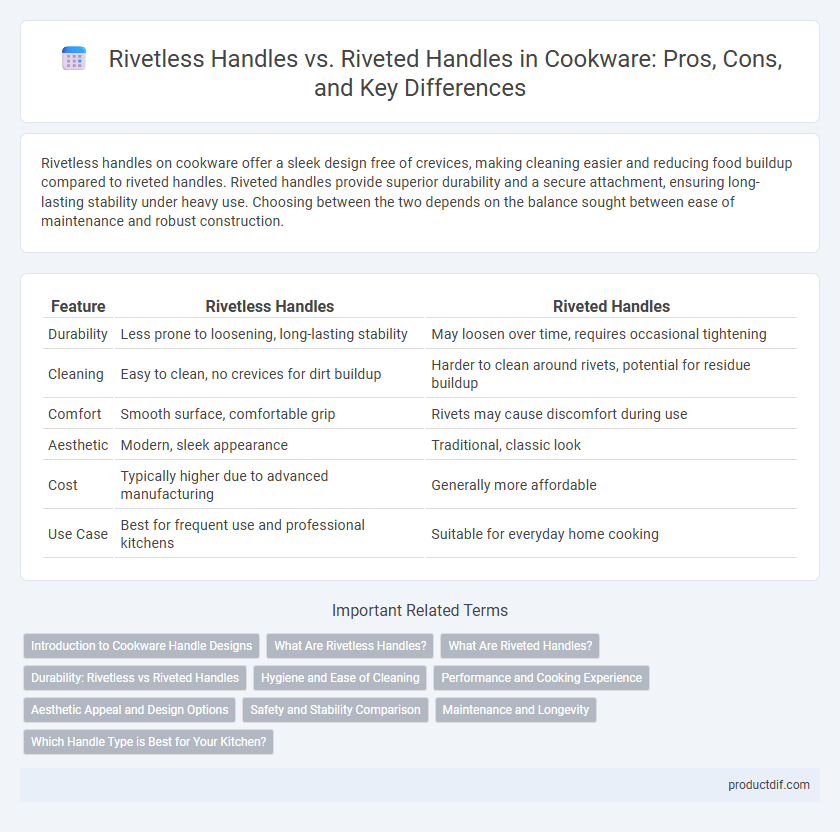Rivetless handles on cookware offer a sleek design free of crevices, making cleaning easier and reducing food buildup compared to riveted handles. Riveted handles provide superior durability and a secure attachment, ensuring long-lasting stability under heavy use. Choosing between the two depends on the balance sought between ease of maintenance and robust construction.
Table of Comparison
| Feature | Rivetless Handles | Riveted Handles |
|---|---|---|
| Durability | Less prone to loosening, long-lasting stability | May loosen over time, requires occasional tightening |
| Cleaning | Easy to clean, no crevices for dirt buildup | Harder to clean around rivets, potential for residue buildup |
| Comfort | Smooth surface, comfortable grip | Rivets may cause discomfort during use |
| Aesthetic | Modern, sleek appearance | Traditional, classic look |
| Cost | Typically higher due to advanced manufacturing | Generally more affordable |
| Use Case | Best for frequent use and professional kitchens | Suitable for everyday home cooking |
Introduction to Cookware Handle Designs
Rivetless handles in cookware offer a seamless, smooth design that enhances easy cleaning and reduces food and dirt accumulation compared to traditional riveted handles. Riveted handles, secured with metal fasteners, provide durable, sturdy attachment but can create crevices challenging to clean. Choosing between rivetless and riveted handles impacts cookware maintenance, hygiene, and overall durability.
What Are Rivetless Handles?
Rivetless handles are integrated directly into the cookware body, creating a seamless connection that eliminates the use of metal rivets. This design reduces crevices where food and bacteria can accumulate, enhancing hygiene and simplifying cleaning. Rivetless handles also provide a sleek, modern look and often improve comfort by offering smooth, uninterrupted surfaces for gripping.
What Are Riveted Handles?
Riveted handles are securely attached to cookware using metal rivets that pass through the handle and the pot or pan, providing durability and long-lasting stability. These handles are often preferred for their strength and reliability, especially in professional kitchens where heavy use is common. The visible rivets may require more cleaning but ensure the handle remains firmly fixed, reducing the risk of loosening over time.
Durability: Rivetless vs Riveted Handles
Rivetless handles offer enhanced durability by eliminating stress points that can weaken over time, making them less prone to loosening or breakage compared to riveted handles. Riveted handles, while historically reliable, may develop rust or corrosion around the rivets and can loosen with frequent use, reducing their long-term sturdiness. Choosing rivetless cookware ensures a seamless connection that withstands high temperatures and heavy use, ideal for professional kitchens or frequent home cooks.
Hygiene and Ease of Cleaning
Rivetless handles on cookware offer superior hygiene by eliminating crevices where food particles and bacteria can accumulate, making them easier to clean compared to riveted handles. Riveted handles often trap residue around the rivets, requiring more thorough scrubbing to maintain cleanliness and potentially harboring germs. Choosing cookware with rivetless handles enhances kitchen sanitation and simplifies maintenance, especially in professional and home kitchens focused on food safety.
Performance and Cooking Experience
Rivetless handles provide a seamless design that enhances cooking performance by preventing food and grime buildup, making cleaning easier and maintaining a smooth surface. Riveted handles offer superior durability and stability due to their strong mechanical attachment, ensuring the handle remains firmly fixed during heavy use. Each handle type impacts the cooking experience differently, with rivetless handles favoring hygiene and ease of use while riveted handles prioritize long-term sturdiness.
Aesthetic Appeal and Design Options
Rivetless handles offer a sleek, seamless look that enhances contemporary cookware aesthetics, making pots and pans easier to clean without visible hardware interruptions. Riveted handles, while traditional, provide a distinct industrial charm and design versatility through various rivet styles and finishes that can complement rustic or classic kitchen themes. Choosing between rivetless and riveted handles depends on the desired balance between minimalist design and handcrafted character in cookware.
Safety and Stability Comparison
Rivetless cookware handles offer enhanced safety by eliminating food and bacteria traps, promoting easier cleaning and reducing contamination risks. Riveted handles provide superior stability and secure attachment, ensuring longevity and resistance to loosening during heavy use. Choosing rivetless handles improves hygiene, while riveted handles prioritize robust durability for demanding cooking tasks.
Maintenance and Longevity
Rivetless handles offer easier maintenance due to their smooth design that prevents food buildup and simplifies cleaning, reducing the risk of bacterial growth over time. Riveted handles provide superior durability and a secure attachment, ensuring long-term stability especially in heavy-duty cookware. Choosing between the two depends on prioritizing ease of cleaning with rivetless or enhanced structural strength and longevity with riveted handles.
Which Handle Type is Best for Your Kitchen?
Rivetless handles offer a sleek design and easier cleaning due to their smooth surfaces, reducing food and grime buildup, while riveted handles provide durability and a secure attachment that withstands heavy use in busy kitchens. Choosing the best handle type depends on your cooking habits: rivetless handles suit those prioritizing hygiene and modern aesthetics, whereas riveted handles are ideal for cooks needing reliable, long-lasting cookware under frequent, intensive use. High-quality materials like stainless steel or cast iron combined with your preferred handle style ensure both functionality and comfort in your kitchen.
Rivetless Handles vs Riveted Handles Infographic

 productdif.com
productdif.com